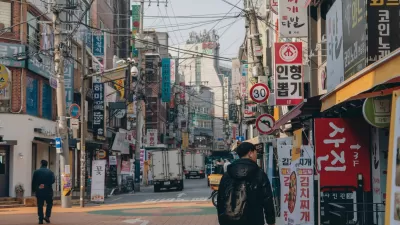Eric Jaffe reports, “[a] recent field test in Mexico offers the first experimental evidence that basic infrastructure upgrades — in this case paving streets — have a measurable effect on reducing urban poverty.”
A street paving pilot project carried out in Acayucan, Mexico, shows a promising, and relatively low cost path for improving life in the developing world. Published in September, the results of a study [PDF] conducted by Marco Gonzalez-Navarro of the University of Toronto and Climent Quintana-Domeque of Universitat d'Alacant showed that simple street paving led to, "a substantial reduction in material poverty."
"Pavement projects boosted housing wealth, which boosted credit use, which boosted household consumption - all for a relatively low cost," writes Jaffe. These findings are based on a comparison of surveys carried out amongst households in communities in 2006, before paving was finished, then conducted again later in 2009. Factors taken into account included monthly expenditures on household items and durable goods, as well as credit usage, loan acquisitions, and changing property values.
"The researchers believe this newfound wealth, tied closely to credit use, was the result of increased home values created by the street surfacing," says Jaffe. "Professional appraisers found that properties along the paved streets rose 16 percent (with land values climbing 54 percent), compared to those on unpaved streets. Rents were 31 percent higher on paved streets, and while there weren't enough home sales to create statistical significance, the trend was clearly toward higher prices - with paved homes going for 85 percent more than their unpaved counterparts."
FULL STORY: A Simple Way to Reduce Urban Poverty: Pave Streets

Trump Administration Could Effectively End Housing Voucher Program
Federal officials are eyeing major cuts to the Section 8 program that helps millions of low-income households pay rent.

Planetizen Federal Action Tracker
A weekly monitor of how Trump’s orders and actions are impacting planners and planning in America.

The 120 Year Old Tiny Home Villages That Sheltered San Francisco’s Earthquake Refugees
More than a century ago, San Francisco mobilized to house thousands of residents displaced by the 1906 earthquake. Could their strategy offer a model for the present?

Alabama School Forestry Initiative Brings Trees to Schoolyards
Trees can improve physical and mental health for students and commnity members.

NYC Outdoor Dining Could Get a Re-Do
The city council is considering making the al fresco dining program year-round to address cost concerns from small businesses.

HSR Reaches Key Settlement in Northern California City
The state’s high-speed rail authority reached an agreement with Millbrae, a key city on the train’s proposed route to San Francisco.
Urban Design for Planners 1: Software Tools
This six-course series explores essential urban design concepts using open source software and equips planners with the tools they need to participate fully in the urban design process.
Planning for Universal Design
Learn the tools for implementing Universal Design in planning regulations.
Ada County Highway District
Clanton & Associates, Inc.
Jessamine County Fiscal Court
Institute for Housing and Urban Development Studies (IHS)
City of Grandview
Harvard GSD Executive Education
Toledo-Lucas County Plan Commissions
Salt Lake City
NYU Wagner Graduate School of Public Service




























